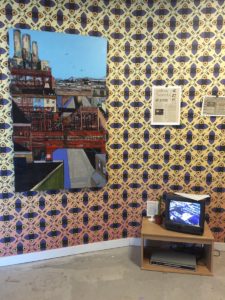Why the Philadelphia Public History Truck’s latest exhibit examines displacement in Chinatown
 June 21, 2016
Category: Featured, Medium, Purpose
June 21, 2016
Category: Featured, Medium, Purpose
Within an hour’s time on a recent Friday afternoon, five people visited the tiny, constructed room nestled in the rear of Asian Arts Initiative to collect socks, water bottles, deodorant and tampons.
The room on the 1200 block of Pearl Street was filled with artifacts of Chinatown past; photographs of old buildings decorated the walls, and a documentary from the 1970s showing residents protesting the construction of the Vine Street Expressway played on loop in the corner.
The toiletries and surrounding items do connect: According to artist Erin Bernard, they both relate to the theme of displacement in the Chinatown neighborhood. It’s why she brought them together for the Philadelphia Public History Truck’s latest exhibit, “A Houseless Museum: Home and Displacement Around the Vine Street Expressway.”
“There are so many different voices in this neighborhood that don’t always align with each other. It often feels like a contested space,” said Bernard, the founder and curator of the History Truck. For this third iteration of the hyperlocal archival project — previously, the truck visited East Kensington and North Philly — it was necessary to find a theme that somehow spoke to the many groups within the community.
Displacement stuck out, partially because of where the neighborhood’s name came from in the first place, and partially because of the presence of Sunday Breakfast Rescue Mission, the city’s oldest homeless shelter, located a block away from Asian Arts Initiative (AAI).
“If we consider displacement over time, it’s easy for us to talk about the history of unhoused communities,” Bernard said. “It’s also easy to talk about the history of Philadelphia’s Chinatown, partly because of the way Chinatown was established in the first place.”
The area got it’s name from the Chinese men who moved to Philadelphia in the mid- to late-19th century because of the racism they were facing in Western American, according to Bernard. The exhibit explores this as well as the development of the Vine Street Expressway — “How do you maintain a sense of home when a number of your neighbors are actually losing their homes?” she said. Ultimately, the community lost its battle against the construction of the expressway but won a smaller one preventing the addition of a ramp along 9th Street.
To develop the exhibit, funded by a project grant from AAI and an Art and Change Grant from Leeway Foundation, Bernard collaborated with AAI, the Rescue Mission and other stakeholders. She also conducted oral histories of the neighborhood with longtime residents.
AAI invited Bernard to bring her exhibit to its space because her participatory approach to constructing the exhibit aligns with AAI’s mission of participatory artmaking, according to Gayle Isa, AAI’s executive director.
AAI had similarly been working to “transform the Pearl Street alley into a neighborhood asset that connects the many diverse constituents along Pearl Street” by “hosting ‘pop up’ events and installations that activate the alleyway, bring more eyes and feet to Pearl Street, and engage people who otherwise might not connect with each other,” Isa said.
As for the toiletries: “I knew from the beginning that if we were going to be using a space on Pearl Street, it had to in some way to be directly useful to the people who spend time on Pearl Street, which are gentlemen who are usually coming to and from the [Rescue] Mission,” Bernard said.
The exhibit will run at AAI through Friday, June 24, on Wednesday and Friday from 1 to 5 p.m. A mobile exhibition will launch in July at the Viaduct Rail Park’s pop-up beer garden, 10th and Hamilton streets.
The next neighborhood Bernard will document is Fairhill, with an exhibit debuting in June 2017. She also has a non-neighborhood-specific project in the works: The Pew Center for Arts & Heritage is funding an exhibit and program series centered on the W.I.C. nutritional assistance program.
Project
Philadelphia Public History TruckTrending News










